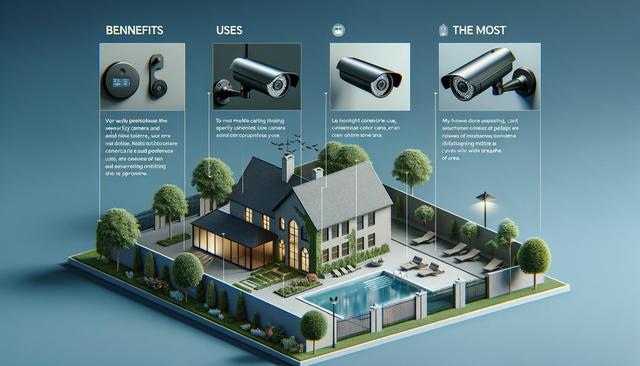Why Security Cameras Are an Essential Layer of Protection
Security cameras have become a valuable tool in modern home protection strategies. With increasing concerns about property crime and unauthorized access, homeowners are turning to surveillance systems as a proactive measure. These devices offer real-time monitoring, evidence collection, and peace of mind, whether you’re home or away. Their presence alone can deter potential intruders, making them a practical investment in any security setup.
One of the core benefits is the ability to remotely monitor your home. Many systems today allow integration with mobile apps, enabling live viewing from anywhere with an internet connection. This feature is particularly useful for homeowners who travel frequently or want to check in on their property while at work. Moreover, security cameras can help with:
- Monitoring delivery drop-offs and preventing package theft
- Capturing video evidence in case of incidents
- Keeping an eye on children or pets while away
- Reducing insurance premiums by demonstrating added security
By offering both a visual deterrent and a way to document events, security cameras are a vital part of any comprehensive home protection plan.
Types of Security Cameras and Their Uses
When selecting a surveillance system, it’s important to understand the different types of security cameras and how they can be used effectively. Each type serves a specific purpose and offers unique features tailored to various environments. The most common camera types include:
- Wired security cameras – Typically offer stable connections and high-resolution video but require professional installation
- Wireless cameras – Easier to install and ideal for indoor use; some models are battery-powered for flexible placement
- Outdoor cameras – Designed to withstand varying weather conditions and often feature night vision and motion detection
- Doorbell cameras – Allow homeowners to see and communicate with visitors remotely
Choosing the right combination of cameras depends on the layout of your property and your specific security needs. For example, outdoor cameras are suitable for monitoring driveways and entrances, while indoor cameras can be used to watch over common areas or valuables.
Features That Enhance Camera Performance
Modern security cameras come with high-tech features that elevate their functionality and user experience. When evaluating camera systems, there are several key features to consider that can significantly improve their effectiveness and convenience. These include:
- High-definition video – Ensures clear and detailed footage for better identification
- Infrared night vision – Allows monitoring in low-light conditions
- Motion detection – Triggers alerts and recordings only when movement is detected
- Two-way audio – Enables real-time communication through the camera
- Cloud storage – Safely archives footage for later review
- Mobile alerts – Sends instant notifications of suspicious activity
These capabilities help users make the most of their systems by providing accurate and timely information. Features like mobile access and cloud integration also allow users to conveniently manage their security from virtually anywhere, enhancing both control and responsiveness.
Installation Tips and Best Practices
To maximize the effectiveness of your security cameras, proper installation is crucial. Placement plays a significant role in capturing useful footage and deterring potential threats. Here are some key tips to consider during installation:
- Position cameras at entry points such as doors, windows, and garages
- Mount cameras at a height to prevent tampering but ensure a clear view
- Ensure lighting conditions are adequate, or choose cameras with night vision
- Angle cameras to cover wide areas without blind spots
- Regularly check and maintain cameras to ensure they function correctly
While professional installation is recommended for wired systems, many wireless and smart camera models are designed for easy DIY setup. Regardless of the method, taking the time to install cameras thoughtfully can make a significant difference in overall security coverage.
Making the Most of Your Security Investment
Simply installing security cameras is not enough to ensure home safety. To truly benefit from your system, it’s important to actively manage and maintain it. This includes reviewing footage periodically, updating software, and responding to alerts promptly. Regular system checks help identify any technical issues before they compromise your security.
Additionally, integrating your cameras with other smart home devices can enhance their effectiveness. For example, pairing cameras with motion-activated lights or smart locks adds layers of protection and automation. Some users also choose to connect their systems to professional monitoring services for added peace of mind.
Tips for maximizing your security camera system include:
- Setting up custom motion zones to reduce false alerts
- Using secure, encrypted connections to protect video data
- Creating a backup plan for power or internet outages
- Training household members on how to use the system
By taking an active role in managing your surveillance system, you can ensure it remains a dependable part of your home protection strategy.
Conclusion: Strengthen Your Home Security with Smart Surveillance
Security cameras offer a practical and effective way to protect your home and property. From deterring criminal activity to providing clear evidence when needed, they serve as a crucial component of modern home security. With a wide range of camera types and features available, homeowners can find solutions that meet their unique needs. By understanding how to choose, install, and maintain a surveillance system, you can build a safer environment for your household and enjoy greater peace of mind every day.


